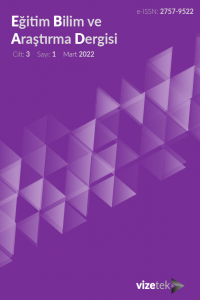Research Article
Theoretical Article
Aim & Scope
Vizetek Publishing Industry and Trade. LLC. The Educational Science and Research Journal (EBAD), which operates within the body, is a national refereed journal and is published twice a year. EBAD includes quantitative and qualitative studies, meta-analysis studies that comprehensively evaluate the literature, model proposals and similar original articles, especially on all fields of educational sciences and other fields of social sciences. In addition, priority is given to current research using advanced research/statistics methods and techniques. In addition to the competencies of the studies in terms of methodology, their original and new contributions to the field are also the main publication criteria.
In line with this general purpose, EBAD aims to be a qualified source of information for researchers who produce information by publishing qualified research results related to education and other social sciences, and for practitioners who use the information produced.
Acceptance of publications in Turkish and English from the fields of Computer and Instructional Technology Education, Educational Sciences, Fine Arts Education, Mathematics and Science Education, Special Education, Basic Education, Turkish and Social Sciences Education, Foreign Language Education, Physical Education and all social and human sciences. is doing.
Author Guidelines
Text
Summary
Short Turkish summary between 200-250 words. There will be no reference in the abstract and abbreviations will not be used.
Keywords
Between 4-6 keywords should be written. Keywords can be used for indexing.
Text Formatting
The text must be submitted in the MS-Word word processor file format (doc or docx). Other file formats will not be accepted.
While preparing the text, the template in the submission files (http://dergipark.gov.tr/journal/1097/submission/start) should be used.
Paragraph and character fonts should not be used in the text.
The automatic title feature of the word processor should not be used.
The text of the text should be written in 10 point Book Antiqua font.
Italic font can be used for emphasis.
Use the word processor's table feature to create tables – , | Do not try to create a table by escaping characters such as _ or _. Absolutely no spreadsheet objects (eg MS-Excel objects) should be used. If copying from a spreadsheet such as MS-Excel, it should be pasted with Paste/Paste Special/Formatted Text (RTF) after copying.
No spaces should be used at the beginning of the paragraph.
Titles
Headings should not be numbered.
No blank line should be left after the title.
Only the first letters of the titles should be capitalized.
More than three levels of headings should not be used. A first-level title should be in bold only, a second-level title in bold and italic, and a third-level title in italic only.
Headings should be with the next text. To do this, right-click on the title text, then tick Keep with Paragraph/Line and Page Break/Next.
abbreviations
Abbreviations should be defined in the first place in the text. Abbreviations should not be used in the abstract.
Footnotes
Footnotes can be included in the text. References should not be included in footnotes. Footnotes should be given on the first page, if possible. Footnotes should be numbered automatically by the word processor. Footnotes should be numbered 1,2,3.. (Arabic format). Footnotes should be preferred over endnotes.
Thanks
The acknowledgment part to be written for the institution, organization or person who contributed to the research and writing of the article should be written just before the bibliography. Abbreviations should not be used in the names of individuals, institutions or organizations.
Scientific Format
Units to be used in the text should be given in SI type.
If possible, generic names should be preferred over brand names. For example, "word processor" should be preferred instead of "MS-Word".
The decimal separator should be either a period (.) or a comma (,) in all text. For example, when expressing the number of pi, it should be 3.14 or 3.14. Or for the level of significance: p < 0.5 should be written. The zero before the dot should be used.
References
All bibliography should be given in APA 6 (http://www.apastyle.org/) format. Another bibliography should be used. Abbreviations should not be used in the names of journals and books in the bibliography. This number should be added to the end of the bibliography with the DOI number.
Tables
All tables should be where they should be in the text.
All tables should be numbered 1,2,3... (Arabic format).
For each table, a table title should be given above the table. The table title should be with the next text. To do this, right-click on the title text, then tick Keep with Paragraph/Line and Page Break/Next.
Headings should be left justified.
The text of the table should be Book Antiqua 10 points. If the tables do not fit on the page (as columns or rows), Book Antiqua can be arranged in 9 points.
Table should be left justified in the text. Table and column width should be adjusted automatically. For this, click the right mouse button in the table, use the "Auto Fit/Auto Fit Content" option in the menu that comes up.
Footnotes in the table should be given with a superscripted asterisk (two stars for the second, three stars for the third ...) and should be located just below the table.
Shapes
All figures should be left aligned and where they should be in the text.
All figures should be numbered 1,2,3... (Arabic format).
For each figure, a figure title should be given under the figure and it should be left aligned
Extended English Summary
Since the articles published in our journal are scanned by international indexes, an extended English summary is required. When preparing:
1. Extended Abstract Page Break should be placed before the Abstract.
2. The title should be at least 850 words including names and keywords.
3. There should be no subtitles in the abstract.
4. When the abstract is read, a general idea about the article should be formed. Without using subtitles for this; Briefly, literature review, problem and method, data collection tools, data analysis process, discussion, conclusion and recommendations should be included.
5. Bibliography should not be used after the Extended Summary.
6. The Extended Abstract should be the last part of the article.
Ethical Principles and Publication Policy
Ethical Principles and Publication Policy
Eğitim Bilim ve Araştırma Dergisi is a journal in which original researches produced in the fields of education are evaluated and published in line with scientific and ethical principles. Ethical principles have an important place in the publication policy of our journal. These ethical principles are accepted by us based on the guidelines prepared by COPE (Committee on Publication Ethics) https://publicationethics.org/. The ethical principles applied by our journal for editors, referees and authors have been established in accordance with these guidelines. The ethical responsibilities of the parties are summarized below, based on the guidelines prepared by COPE.
Editors' Ethical Responsibilities
• To discuss the journal policies in the editorial board and to evaluate the effectiveness of the policies.
• Informing the referees, authors and researchers about the publication and ethical principles of the journal and taking into account their feedback.
• To make a preliminary evaluation of the articles sent to the journal for publication in terms of compliance with the journal's publication policy, originality, contribution to the field and competence.
• Informing the authors of the articles that are not suitable for publication as a result of the preliminary evaluation, taking the ones that are decided to be published in the publication process.
• Assigning field editors and/or referees who have expertise on the subject of the article to the articles that are in the publication process.
• To ensure that the articles included in the publication process are evaluated according to the blind refereeing and evaluation process.
• To prepare a detailed guide for the authors who will send articles to the journal and to answer the questions from the authors in an explanatory way.
• To determine the field editors and referees to be assigned to the articles in an objective way in accordance with the field of study of the relevant publication.
• Meticulously applying the double-blind evaluation process between the referee and the author.
• To intervene in cases where there is a conflict of interest between the referee and the author.
• To encourage referees to make timely, impartial and effective evaluations.
• Plagiarism scanning of the articles sent to the journal and informing the author about the unsuitable ones.
Ethical Responsibilities of Referees
• Refusing to evaluate articles that do not fall within the field of expertise.
• Evaluate the articles on a double-blind basis.
• To act impartially and in accordance with scientific principles in the evaluation process
• Explaining the reasons for the decision regarding the publication status of the article in the peer-review form.
• Using a polite and respectful language in accordance with scientific principles
• Evaluating the articles within the time given to them.
Ethical Responsibilities of Authors
• Not sending the articles they sent to the Educational Science and Research Journal to another journal simultaneously.
• To write articles objectively in accordance with scientific research method and report writing principles.
• To include all citations in the article in the bibliography, to refer to the sources in the bibliography within the text.
Price Policy
Our journal does not charge any fee for article submission or article processing fee.
Journal Boards
Editör-in-Chief

Editor

Editorial Board





PhD in Art History (Universitat de València, 2005). He has taught at the Universitat Politècnica de València and the Universitat Oberta de Catalunya. Since 2010 he teaches Art History and Film History at the Universitat de València.
As curator he is responsible for several international exhibitions dedicated to HR Giger (València 2007; Sant Sebastià 2009; Gruyerés 2017; Nantes 2017, Ciutat de Mèxic 2019; Barcelona 2021; Tabasco 2022), José Hernández (València, Madrid 2016; Denia 2022, Alcoi, Villena 2023), Joan Castejón (València 2017; Denia 2022), Film Design (València 2009) and Fantastic Art (València i Alacant 2013; Sant Sebastià 2014; Tabasco 2023).
In addition to conferences and lectures on art, film and avant-garde art, he has published numerous articles in specialized magazines and exhibition catalogs related to art and fantastic cinema.
As a screenwriter he has worked in television (Culto Cinemascope, Rolling Stone Colombia 2021) and film (Bayne Studios, New York, 2023).


Lisans: Hacettepe Üniversitesi
Yükseklisans: Amasya Üniverstiesi
Doktora: Gazi Üniversitesi


Serkan COŞTU, who is married and has 3 children, was born in 1980 in Karabük. He completed his primary education at Karabük Demir-Çelik Primary School and middle school at Karabük Anatolian High School. Then, he attended his education at Çankırı TOBB (Süleyman Demirel) Science High School. After that, he started his education at Gazi University, Faculty of Education in Elementary Mathematics Teaching Program. He completed bachelor degree in 2003 and started his career as a teacher at Trabzon MoNE. He resigned from his job and November 2004 at started to work as a research assistant at Kafkas University. Later on September 2005, he was appointed do postgraduate education at Karadeniz Technical University. In 2009, he completed his master's degree in Elementary Mathematics Education. Between the years of 2009-2011, he take part in his doctoral studies and attended some projects and researches in Sweden and Denmark. After returning to Turkey, he gave his doctorate qualification and he participate in various projects within the scope of his work. In 2016, he went back to Kafkas University and is currently working in the Department of Elementary Mathematics Education at Dede Korkut Education Faculty.


He was born in Çanakkale. He graduated from the Biology Education undergraduate program of Kazım Karabekir Faculty of Education, Atatürk University in 2003. He worked as an English teacher at Erzurum Atatürk Primary School in the 2003-2004 academic year. He worked as a research assistant at Atatürk University in 2004, at Rize University (Recep Tayyip Erdoğan University) in 2008, and at Karadeniz Technical University in 2009. In 2011, he participated in the Erasmus Program (Erasmus IP) on sustainable development organized in Daugavpils University, Latvia. In 2012, he conducted research for 12 months in middle and high schools in the Los Angeles area through California State University, Long Beach with a TUBITAK Doctoral Sequence International Research Scholarship. In 2014, he completed his PhD in Biology Education in the Department of Secondary Science and Mathematics Education at KTU Institute of Educational Sciences. That same year, he was appointed assistant professor in the Faculty of Education at Bartın University. Between 2014 and 2016, he served as both Head of the Department of Science Education and Associate Dean. He was awarded the title of Associate Professor in Biology Education in 2019. He was appointed Professor in 2024. He currently teaches undergraduate and graduate courses in Biology Education, conducts research on socioscientific issues, the use of technology in education, measurement and evaluation, and teacher education, and continues to serve as a faculty member in the Department of Science Education at Bartın University's Faculty of Education.

